The Hawaiian Reef with Everything
When I dive in an unfamiliar area, I tell the dive operator I want to start at their best spot — the site with everything. If I get bored with that, maybe I’ll try other sites. If you came to my home turf on the Kona Coast of Hawaiʻi Island and asked me for the site that has everything, I would send you to Ripoff Reef. It’s obviously a rip-off because you’ll pay full fare for the dive boat, and then they will drive you maybe three minutes outside the harbor entrance and tie up to a mooring right next to the boat channel. During the dive, you’ll hear big boats racing overhead, and you’ll be swimming in effluent from the wastewater treatment plant.
The boat noise is terrifying only if you venture onto the shallow reef right at the harbor entrance, and the wastewater effluent is treated, so it poses no hazard to human health. It carries nutrients and assorted byproducts of human civilization presumed to be unhealthy for corals. Yet, perhaps due to the proximity to deep water and vigorous currents that often sweep past, a very healthy hard coral reef tumbles down the slope from the boat moorings to the sand channel.
Ripoff Reef is one of many names for the site, which is also known as Naia (Hawaiian for dolphin), Manta Ray Bay, and Honokōhau. Shore divers call it House Reef, Crescent Beach, Dog Beach, or Alula Beach. After making the dodgy hike across jagged black lava to the shore-entry beach, all while suited up and loaded down with dive and camera gear, few divers ever refer to the site as Ripoff Reef again.
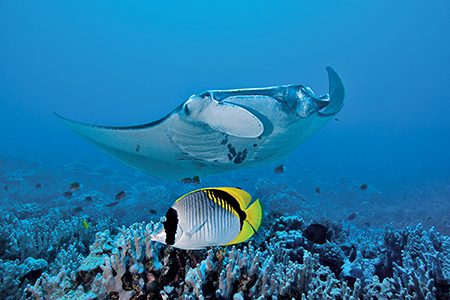
So what do I mean by everything? Repeated sightings here include turtles, sharks, dolphins, whales, manta and eagle rays, cephalopods, assorted eels, colorful schooling tropical fish, rare endemic Hawaiian fish, and a kaleidoscope of frogfish, baitballs of akule (scad), shelled mollusks, shrimp, crabs, and nudibranchs. Over the years I have heard of beaked whales, sailfish, swordfish, and Hawaiian monk seals making appearances.
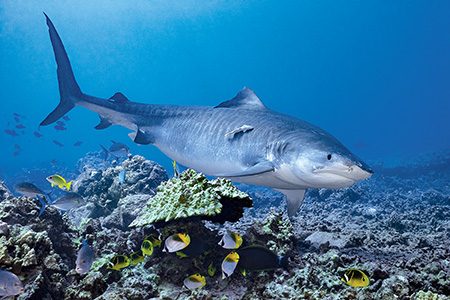
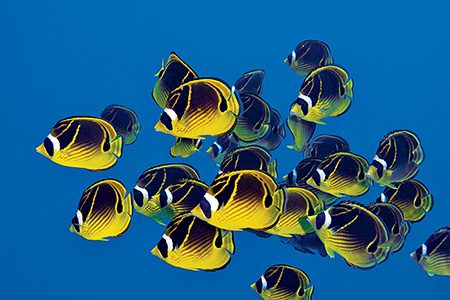
You won’t see everything every day. Each dive is different, which is why some local divers have dived this one site multiple times per week for years or even decades.
One reason this site offers such a variety of marine life is that it encompasses several different habitats: a shallow reef, a deep reef, a sand flat, and an algal field. Yes, there’s reef diving and muck diving on the same dive! Some critters here spend most of their time hidden, others visit only sporadically, but some stay in the same spot for weeks or longer.
Apart from avoiding the risks of hyperthermia or a turned ankle, broken bone, or shattered equipment while negotiating the hike in and out from the shore-entry beach, a boat tour offers other significant advantages, such as typically getting a guide who knows where to find all the regular critters and having the opportunity to do a second dive. Honokōhau usually offers good visibility, especially in the deep channel, and is one of only a few locations protected from a south or southwest swell.
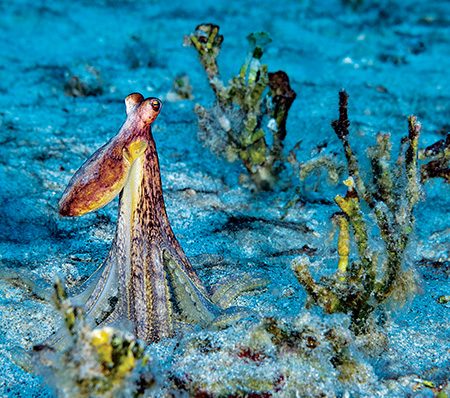
Tiger sharks cruise every part of the Hawaiian coastline and mostly pass unnoticed, but they tend to regularly visit the main fishing harbor, where catches are cleaned and sometimes discarded whole. Divers who keep their heads on a swivel throughout the dive have a good chance of spotting a tiger shark in the distance, at which point the shark usually fades beyond the limits of visibility. Divers who keep an eye glued to their macro rig’s viewfinder have a much lower chance of a shark sighting, but they are more likely to be startled by one passing nearby, not having been put off by human eye contact. Yes, mere eye contact is a highly effective shark repellent.
There must be thousands of passes within visual range between sharks and divers here every month without incident. There are rumors of at least one injury sustained by a diver who illegally fed the sharks. Unlike the celebrities of Tiger Beach, Bahamas, the sharks here have not been conditioned to interact with humans feeding them. Repeat visits are the best formula for an eventual close but safe viewing.
Sandbar sharks regularly visit the deeper parts of the channel, and divers are more likely to see them in the early morning or late afternoon. In times past, when the green can buoy marking the harbor entrance was moored in a little more than 100 feet (30 meters) of water, a common pastime was descending to the mooring and using a hard object to bang on the mooring chain to attract sharks. The new buoy is moored in shallower water, about 85 feet (26 meters), so dropping in further out and using a noisemaker (such as squeezing a half-empty plastic bottle) while drifting in midwater provides better results.
The new buoy location, however, seems more attractive to certain other species. Rare endemic Hawaiian green lionfish often choose the large chain links on the mooring as their preferred hiding places. A sizeable major harp shell is usually buried in the sand close to the mooring but occasionally emerges to cruise briefly across the sand bottom before burrowing into safety again. Kona crabs make forays from their hiding places less frequently, while snake eels usually show only their heads. Endemic Hawaiian garden eels wave in the distance and retract into the sand as divers approach. Eagle rays sometimes feed here but likewise do not tolerate divers swimming up to them. Endemic Hawaiian knifefish are always around, often passing unnoticed as they blend in well with the sand.
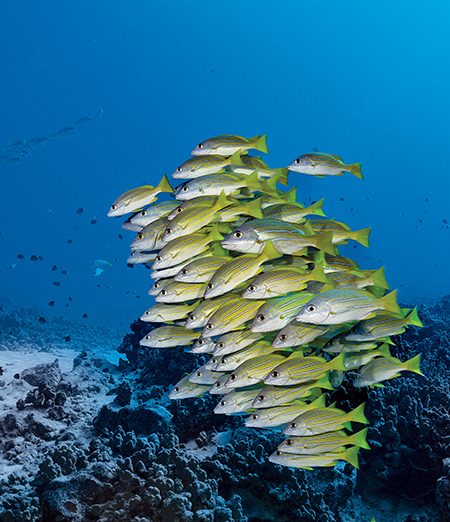
Tufts of flat-bladed algae densely populate the sand beyond the buoy mooring in a field sloping down toward deeper water. Younger divers generally have the visual acuity to spot the tiny white Shaun the Sheep nudibranchs and tiny anemones on the algae, while more seasoned veterans like me have more success looking for darker objects about the size and shape of a human thumb sticking out of the sand.
One of these objects could be the head of a Hawaiian long-armed sand octopus, a poorly studied relative of the mimic octopus that has not yet been scientifically described and is likely endemic to Hawaiʻi. Patient and still observation can yield fascinating behaviors, including mimicry. I once saw two males competing for a single female and flashing a wild array of color patterns. This area has also produced sightings of the rare and endemic Hawaiian short-armed octopus.
The sandy channel is also an attraction for Hawaiian spinner dolphins, which are believed to prefer relatively shallow white sand bottoms to make it easier for them to spot tiger sharks stalking their silhouettes from below. Honokōhau is one of the preferred resting and socializing areas for spinner dolphins in West Hawaiʻi. They are present about one day out of four or five. Pursuing them is futile and illegal, but a calm and observant diver may be rewarded with several sightings during a dive and perhaps an occasional close pass.
Humpback whales rest in the boat channel on rare occasions during the winter season. If dolphins are also there, it’s game on. Academics might take issue with me referring to these interactions as play, but I challenge anyone who has seen a video of the behavior to describe it as anything other than joyful exuberance. Pursuing whales in Hawaiian waters is likewise futile and illegal (with a larger fine), but quietly hanging close to the reef to observe the spectacle can reveal the experience of a lifetime. The marine police station is located at Honokōhau Harbor, and they do not take kindly to people misbehaving with whales, dolphins, or sharks.
Bottom time is limited in the sand channel’s depths, and the worst thing that could happen would be having to surface among the speeding power boats in the boat channel. Following the slope of the sand up toward the harbor takes you to a circle of rocks populated by cute little redspotted sand perch before you hit the reef. In the summer you may see tiny bright yellow and red rubber ducky nudibranchs on the sand.
Various eels populate the reef’s lower part in about 40 to 75 feet (12 to 23 meters) of water. It’s also where you might spot a manybar goatfish tailing a day octopus, hoping to snatch prey fleeing from the reef crevices as the octopus probes them. You may see a school of Heller’s barracuda or raccoon butterflyfish as you ascend further.
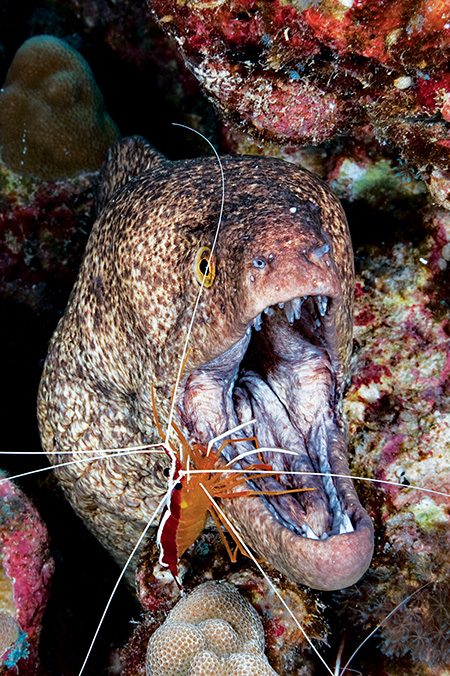
As you reach the boat moorings in 15 to 20 feet (4.6 to 6 meters) during summer, you could find the mooring lines obscured by schools of yellowfin and square-spot goatfish. Watch closely, and you may notice endemic Hawaiian saddle wrasses and other small fish pursuing them relentlessly to feed on their droppings.
Did I mention excrement-eating fish in the list of attractions? Add that to your marine life list and pat yourself on the back for completing an awesome low-carbon-emissions dive. Farther is not always better.
© Alert Diver — Q2 2024